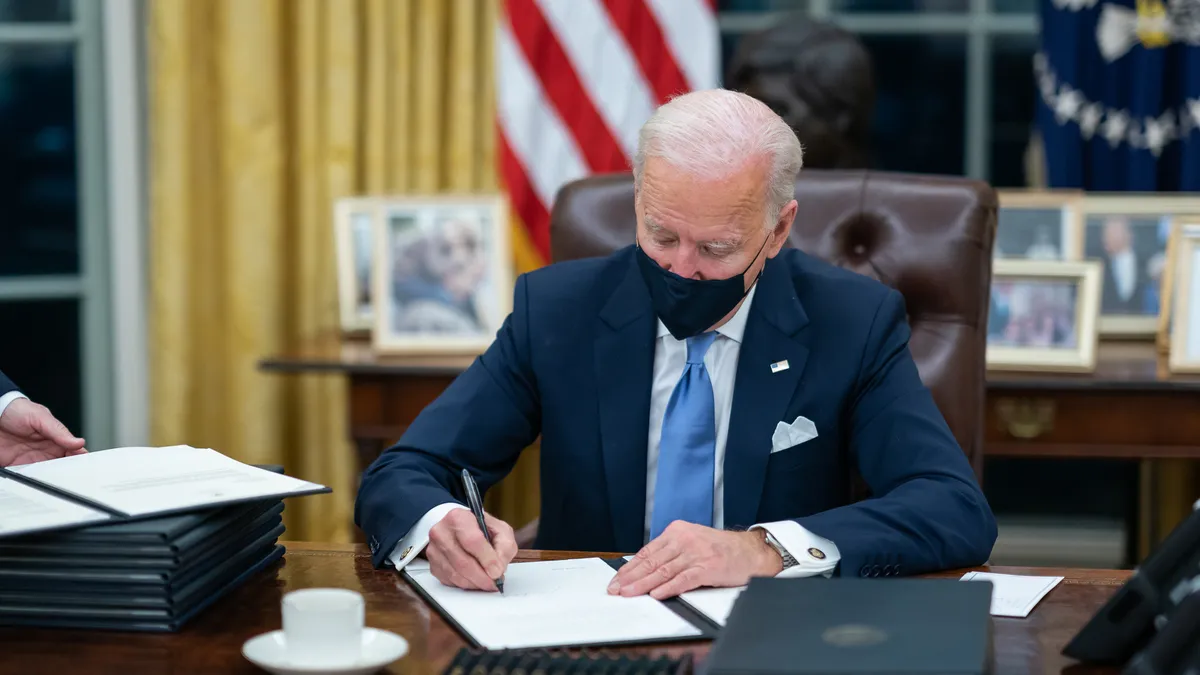Dive Brief:
-
The Government Accountability Office (GAO) called for efforts to achieve fiscal sustainability, noting that spending on pandemic aid pushed up federal debt to about 100% of gross domestic product in fiscal year 2020 from 79% the prior year.
-
U.S. debt will likely hit a record in 2028 and grow faster than GDP thereafter, increasing the odds of a fiscal crisis that could trigger a large fall in the dollar or prompt reluctance among policymakers to support the economy during a downturn, according to the GAO, the congressional watchdog agency.
-
“The government must turn its attention to developing a strategy to deal with our debt and put the government on a long-term sustainable fiscal path,” Gene Dodaro, U.S. Comptroller General and head of the GAO, said in a statement, adding “our rate of debt growth cannot be maintained indefinitely.”
Dive Insight:
Biden administration officials are reportedly drawing up a $3 trillion plan for infrastructure and other projects just weeks after the president signed a $1.9 trillion package that increased total coronavirus relief to about $6 trillion.
Rising U.S. spending poses a scenario in which “investors lose confidence in the government’s ability to service its debt and therefore demand significantly higher interest rates to compensate for the risk,” according to the Congressional Research Service (CRS).
Concerns on Wall Street about federal spending could complicate efforts to manage the debt, Moody’s Investors Service said in a March 24 report.
Large U.S. deficits and debt have “raised market concerns about the potential for higher inflation and interest rates, which could weigh on the U.S.’s debt affordability,” Moody’s said.
Partisan tensions in Congress reduce the odds of an improvement in the fiscal outlook anytime soon, Moody’s said. “The current political climate will likely make bipartisan consensus on fiscal policymaking a challenge.”
As a result “the U.S.’s credit profile will not remain immune to rating pressure in the absence of shifts in fiscal policy in the coming years to reduce the government’s fiscal deficit and stabilize its debt burden,” Moody’s said.
Still, the U.S. has a “significantly higher capacity to carry a larger debt burden than other sovereigns globally due to the very large size and proven resilience of the U.S. economy and the global dominance of the U.S. dollar as the world’s preeminent reserve currency,” Moody’s said.
Congress should create a long-term plan for fiscal sustainability, including rules such as a debt-to-GDP target, the GAO said.
“Lawmakers will also need to consider the entire range of federal activities,” including both revenue and spending, the GAO said, noting that “rising federal debt increases the likelihood of a fiscal crisis.”
The government could improve the fiscal outlook by closing the annual $381 billion gap between taxes owed and those paid and reducing disbursements that should not be made or that are made for an incorrect amount, the GAO said. Such errors during fiscal year 2020 totaled $206 billion.
“The point at which the level of U.S. might become unsustainable is unclear,” the CRS said in a March 23 report, adding “the size of the debt may become a more urgent concern in the future” depending on the strength of the recovery and changes in interest rates and inflation.
Research by some economists suggests U.S. debt is already unsustainable, the CRS said, noting that “countries with debt-to-GDP ratios above 80% and persistent trade deficits are vulnerable to rapid fiscal deterioration.”













